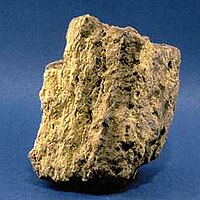
Photo from wikipedia
The Zhesang gold deposit of southeastern Yunnan is an important component of the Dian-Qian-Gui (Yunnan, Guizhou, and Guangxi) “Golden Triangle”, which hosts a multitude of Carlin-like gold deposits (CLGDs). Calcite… Click to show full abstract
The Zhesang gold deposit of southeastern Yunnan is an important component of the Dian-Qian-Gui (Yunnan, Guizhou, and Guangxi) “Golden Triangle”, which hosts a multitude of Carlin-like gold deposits (CLGDs). Calcite is one of the most common gangue minerals in Zhesang. The calcites that have been found in the mining area are classified as ore-stage and post-ore calcites. The ore-stage calcite exhibits a clear paragenetic relationship with gold-bearing arsenopyrite and with an alteration halo that has been cut by the post-ore calcite. To elucidate the origin of the ore-forming fluids of the Zhesang gold deposit and to investigate the possibility of utilizing calcite geochemistry as prospecting indicators, the rare earth elements (REEs), Y, Fe, Mn and Mg contents, and C-O isotopic compositions of calcites from Zhesang have been analyzed. The ore-stage calcite is enriched in middle rare earth elements (MREEs) relative to light rare earth elements (LREEs) and heavy rare earth elements (HREEs) (MREE/LREE = 1.11–1.61, MREE/HREE = 6.12–8.22), whereas post-ore calcite exhibits an enrichment in LREE (LREE/HREE = 4.39–14.93, MREE/LREE = 0.35–0.71). The ore-stage and post-ore calcites were both formed by hydrothermal fluids; however, these hydrothermal fluids may have different sources. The Fe contents of the ore-stage calcite are significantly higher than those of post-ore calcite (4690–6300 μg/g versus 2030–2730 μg/g). Ore-stage calcite also has significantly lower δ18OV-SMOW values than post-ore calcite (11.03–12.49‰ versus 16.48–17.14‰). These calcites with an MREE/LREE ratio greater than 0.92, MREE/HREE ratio greater than 5.69, Fe content greater than 3827 μg/g, and δ18OV-SMOW value less than 14.40‰ represent ore-stage calcites and are important prospecting guidelines. According to the REE, C-O isotopic characteristics of the calcites and the previous findings, it is inferred that the ore-forming fluids of the Zhesang gold deposit were a mixture of crustal fluid by meteoric water leaching wall rocks and a small amount of basic magmatic fluid. The formation of post-ore calcite might be derived from meteoric water and marine carbonates interaction. The ore-forming fluids of the Zhesang gold deposit may be associated with the intrusion of diabase that outcrops in the mining area, and that the basic magmatic activities of the Indosinian period also provided some of the ore-forming materials and heat for gold mineralization.
Journal Title: Minerals
Year Published: 2020
Link to full text (if available)
Share on Social Media: Sign Up to like & get
recommendations!